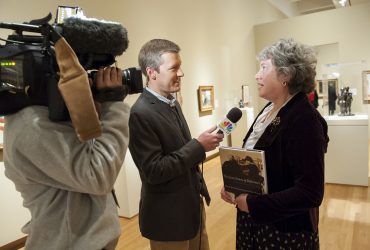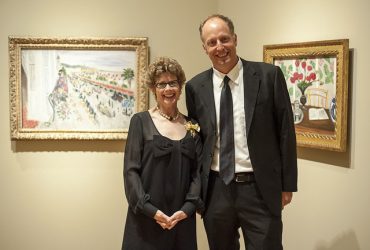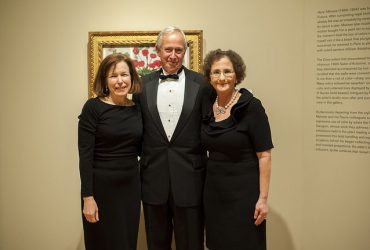Collecting Matisse and Modern Masters: The Cone Sisters of Baltimore

The Nasher Museum presented an exhibition featuring more than 50 masterpieces by Henri Matisse, Pablo Picasso, Paul Gauguin, Pierre-Auguste Renoir, Vincent van Gogh, Camille Pissarro and others.
Collecting Matisse and Modern Masters: The Cone Sisters of Baltimore told the story of two Victorian-era sisters whose remarkable collection was financed by their brothers’ textile empire in North Carolina in the first half of the 20th century. The Nasher Museum was the third and final venue for the exhibition, which originated at the Jewish Museum, NY.
Ahead of Their Time

Matisse called Claribel and Etta Cone “my two Baltimore ladies.” The Cone sisters bought art directly out of the Parisian studios of avant-garde artists, starting in 1905. At a time when critics disparaged Matisse, and Picasso was virtually unknown, the Cones boldly supported them and eventually amassed one of the world’s greatest collections of modern art.
“We are thrilled to present this stunning exhibition, which tells a very special North Carolina story,” said Nasher Museum Director Sarah Schroth. “For the first time, visitors will be able to comprehend the complete and fascinating picture of the Cone sisters as collectors through their incredible purchases of master paintings, prints and drawings, as well as fabrics, laces and jewelry from around the world, personal letters and diaries.”
Independent Income, Love for Art & Confidence

The Cone collection began in 1898, when Etta Cone received $300 from her brother, Moses, to redecorate the family home after their father’s death. Rather than buy new curtains or wallpaper, Etta purchased five paintings by the American Impressionist Theodore Robinson at the artist’s estate sale in New York.
Claribel and Etta Cone went on to build an extraordinary modern art collection because of a special set of circumstances: independent income, love for art and confidence.
Over the course of 50 years, the sisters amassed some of the most important paintings and drawings by Henri Matisse and Pablo Picasso, long before either artist was famous. They bought work they loved—and filled every possible inch of wall in their home.
The Cone Family Legacy

At the turn of the last century, the sisters were friends with Gertrude Stein and her brother, Leo, in Baltimore. The Cones and Steins traveled to Europe together to visit museums, galleries and artist studios. They attended the Salon d’Automne in 1905, where they first encountered Matisse’s bold paintings.The sisters met artists, writers and other art world luminaries at the Steins’ apartment. Years later, the sisters bought paintings from the Steins, including Picasso’s Woman with Bangs.
Over the next few years, Etta learned all she could about art; and Claribel found herself more interested in art than medicine. Together, they worked on growing their collection with few outside influences.
Etta’s grief over the death of her brother, Moses, in 1908, and then the outbreak of World War I interrupted the sisters’ travel and collecting. In the early 1920s the sisters lived in adjoining apartments in Baltimore. Each summer, they traveled to Europe to buy more art.
When Claribel died in 1929, Etta continued to acquire major works of art and fill out the Cone collection. Her ongoing visits and correspondence with Matisse may have influenced her to collect work by artists who inspired him: Cézanne, van Gogh and Gauguin. Etta died in 1949 and gave the entire collection to The Baltimore Museum of Art along with funds to build the new Cone Wing. After The Baltimore Museum of Art made its selections, the rest of the collection went to the Women’s College of the University of North Carolina in Greensboro, now the Weatherspoon Art Museum.
Support

Collecting Matisse and Modern Masters: The Cone Sisters of Baltimore was organized by The Baltimore Museum of Art, The Jewish Museum, New York, and the Vancouver Art Gallery.
In Durham, the exhibition was presented in collaboration with the Nasher Museum of Art at Duke University.
At the Nasher Museum, lead foundation support was provided by the Crow Creek Foundation. Lead corporate support was provided by Wells Fargo. The media sponsor was NBC17. Major support was provided by the Mary Duke Biddle Foundation, William R. Kenan, Jr. Charitable Trust, Marilyn Arthur, Trent Carmichael, Carol O’Brien Associates, Inc., Katherine Thorpe, Office of the President at Duke University, Office of the Provost at Duke University, Frances Rollins, Drs. Victor and Lenore Behar, Christie’s, and Thomas S. Kenan, III. Additional generous support was provided by the Cemala Foundation, Stefanie and Douglas Kahn, Kelly Braddy Van Winkle and Lance Van Winkle, Graduate Liberal Studies at Duke University, Parker and Otis, Jo and Peter Baer, Pepper and Don Fluke, Mindy and Guy Solie, Carolyn Aaronson, Marcia Angle and Mark Trustin, Clinical Ambassador, Diane Evia-Lanevi and Ingemar Lanevi, Janet Holderness and William Transou, Caroline and Arthur Rogers, Angela O. Terry, Ruth Glesby Wagner, and Jewish Life at Duke. This exhibition was supported by an indemnity from the Federal Council on the Arts and the Humanities.






